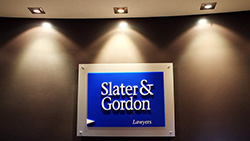
Aggressive UK acquisition strategy drives Slater & Gordon
In the past year the Slater & Gordon (ASX:SGH) share price has doubled to $4.00, giving the company a market capitalisation approaching $800m. Specialising in personal injury insurance and litigation services including everything from asbestos and medical law to workers compensation law, Slater & Gordon has 69 offices in Australia. The company also has, we believe, strong medium-term prospects thanks to an aggressive acquisition strategy into the highly fragmented UK law industry.
This market is four or five times bigger than the Australian market and with five UK acquisitions under its belt including Russell Jones & Walker, Claims Direct, and more recently Taylor Vinters and Goodmans & Fentons Solicitors, Slater & Gordon is leading the consolidation of the UK personal legal services market. These UK operations have forecast annualised revenue of A$140m and potential EBITDA margins of 20 per centwhile revenue from the Australian operations should exceed $240m with EBITDA margins of 25 per cent.
The three UK acquisitions so far this financial year are expected to cost $74 million and be earnings-per-share accretive in their first year under Slater & Gordon’s ownership. In other words they will immediately add to the earnings on a per share basis. Fentons Solicitors is the UK’s largest specialist direct-to-consumer personal injury firm. As Slater & Gordon continues their acquisition strategy, we expect revenue from the UK will exceed that of Australia.
Slater & Gordon’s ambition is to become a household name in UK consumer law, and position itself for a tsunami of disruptive innovation in the global law industry. The strategy is partly succeeding because the market is pricing Slater & Gordon on at least double the multiple the company itself is paying for its UK purchases. When this occurs it is either self-fulfilling arbitrage opportunity or a warning that the market has rallied well ahead of trade sale prices. While the company appears expensive on 19 times historical earnings, Slater & Gordon could be a worth a lot more in five years.
Few small-cap Australian companies have such a clear opportunity to consolidate a huge, fragmented offshore market and capitalise on structural industry changes just as the UK. The UK legal services market is undergoing rapid consolidation as difficult trading conditions post-Global Financial Crisis (GFC) and regulatory reform have shaken what some commentators describe as a “cottage industry” to its core. Clients want lower fees, better service and greater value; the UK government wants greater competition.
In October 2011 the UK allowed a range of alternative business structures, including incorporated law firms that could be owned by non-lawyers, as is Australia’s practice. The upshot was incorporated firms could raise external capital and rapidly acquire smaller players. Another change was a UK Parliamentary Review that called for claims management companies (CMCs) in the UK to be closed down from April 2013. Much like mortgage brokers, CMCs advertised for personal industry claims and on-sold them to law firms, in turn increasing consumer costs and taking the onus off law firms to develop a strong consumer brand. Some disreputable CMCs also damaged consumer trust in personal injury claims.
The UK has more than 10,000 law firms, with almost two-thirds of them owned by one or two partners. Slater & Gordon says there have been high rates of distress among small UK law firms and CMCs that previously sourced personal-injury claims for the legal industry. The obvious solution has been industry consolidation as firms merge to create scale, or larger firms buy smaller rivals – a pronounced trend in the global legal industry in recent years. But most UK law firms had low access to capital, little experience in acquiring other firms, a weak brand in the consumer market, and no clear, sustainable competitive advantage over rivals.
This has created a huge opportunity for Slater & Gordon, which with its access to capital since its Initial Public Offering (IPO) in 2007 and its long experience in acquiring and integrating firms, now has 25 per cent of the Australian personal-injury market.
It also has a strong sustainable competitive advantage: intellectual property that helps it choose the best personal-injury cases to pursue, internal systems that help it process tens of thousands of claims each year, improved margins as it builds scale and efficiencies and a well known brand. Unlike smaller law firms, Slater & Gordon has the balance-sheet firepower to invest heavily in its brand, systems as well as an ability to make rapid acquisitions.
The company raised $58.9 million in May 2013 and net debt at 30 June 2013 stood at $32m. For all the positives, Slater & Gordon’s Return on Equity (ROE) has fallen from almost 22 per cent in F’08 to 15.5 per cent in F’13, and consensus analyst forecasts have it around 15 per cent for the next three financial years.
That said, Slater & Gordon has good medium-term upside, given its expanding UK footprint, ability to create scale, and brand and intellectual property. Slater & Gordon’s ambition is to replicate its Australian success – 78 years in the making – within a decade in the UK.